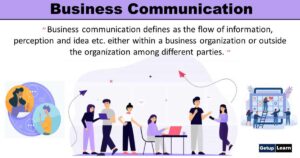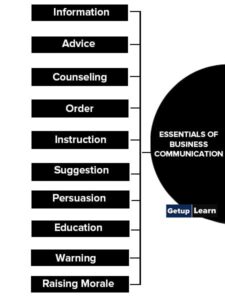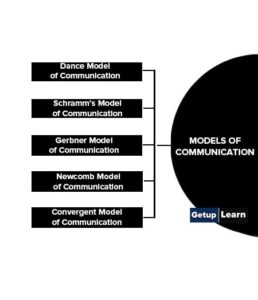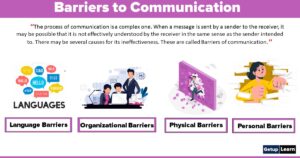Elements of communication refer to the basic components involved in an act of communication. These elements are also called the universals of communication because they are present in every communication act.
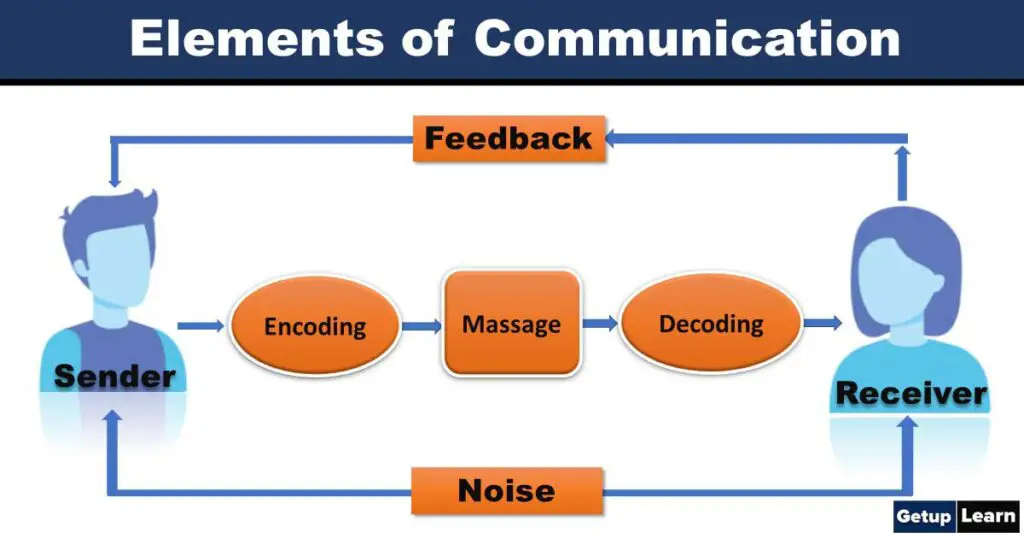
Table of Contents
Let us analyze Joseph A Devito’s definition that ‘communication refers to the act by one or more persons, of sending and receiving messages distorted by noise, within a context, with some effect and with some opportunity for feedback’ to find out the essential elements of communication.
Table of Contents
Elements of Communication
The following are the elements of communication:
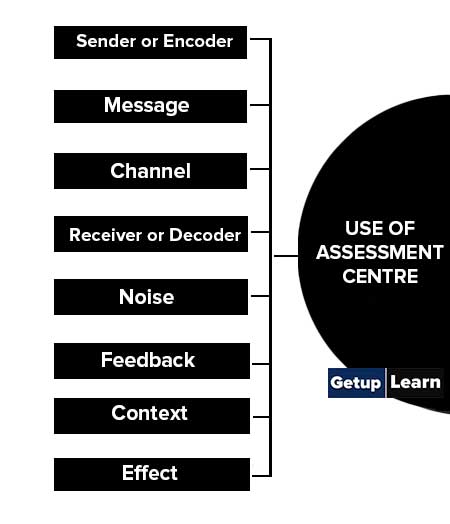
Sender or Encoder
The sender is the idea-generating component in the communication process. In human communication, the sender may be a person or persons who create or formulate the message to be sent to the receiver. Being the primary source of the message, the sender is also termed the source.
In mass media, for example, a news reporter is the sender or source as he/she constructs the message (news story). In a musical performance, the singer is the sender as his message is enjoyed by the audience.
The sender is a critical component in communication as his/her social background, personality status, education, etc influence the quality of the message he/she creates. The message is created from the idea generated in the mind of the sender. The idea generation process is called encoding.
The source/sender has three functions:
- To decide what is to be communicated.
- Encoding (Put the idea in such a way that the receiver understands it)
- Transmitting the message to the receiver.
Message
The second element of the communication process is the message or the information that is being communicated. The source encodes an idea and then determines whether or not to inform, persuade, or entertain. After deciding what message to send, the source uses symbols to get the message across to others.
In other words, The message is any verbal or non-verbal method that produces meaning in the mind of the receiver. Simply, it is the meaning transferred from the sender’s mind to the receiver’s mind. This happens mainly in two ways: verbal and non-verbal methods.
Verbal message
The verbal message means written or oral messages. They are composed of words. Example: A newspaper report or a lecture by a teacher.
Non-verbal messages
Non-verbal messages are those communicated through our behavior, movements, actions, clothes, style of conversation, the pitch of the sound, etc.
What is fundamental in message construction is the agreement between sender and receiver in the code used for it. If the receiver cannot identify the language or meaning of the message, the communication will be defective.
Channel
The channel means the medium by which the sender transmits the message to the receiver. Our five senses hearing, touching, smelling, tasting, and seeing are basic natural channels of human communication. Communication can be classified on the basis of five basic natural channels. They are:
Tactile communication: Communication by touch or taste
Olfactory communication: communication by smell
Audio communication: Communication through sound waves
Visual communication: Communication through visual elements or properties.
We use any technology-developed medium (like television, newspaper, books, etc) with the help of one or more of these five senses. Similarly, the sender uses one or more channels to maximize the communication effect. For example – the multi-media classroom where the teacher uses a projector, blackboard, lecture, gestures, etc. simultaneously.
Receiver or Decoder
The Idea receiving end in the communication process is called the receiver. A person or thing may be at the receiving end. The receiver’s role is as important as the sender’s role. As in the case of a sender, the receiver has also three roles to play
- To receive the message
- To decode the message
The person (or persons) who attends to the source’s message is the receiver. The act of interpreting messages is called decoding. Receivers decode messages based on past experiences, perceptions, thoughts, and feelings. We receive messages through all our senses, but most often we decode messages by listening or seeing.
We first have a physiological reception of stimuli (a noise causes sound waves to hit our eardrum or a movement catches our eye). We then pay attention to both the verbal and nonverbal stimuli and reduce all the stimuli bombarding us to one or two we can cope with more easily.
Next, we try to understand the stimuli and interpret them into messages (we decide that the noise is a telephone bell or that the movement is a friend waving to us across campus). Finally, we store this information for later use so that next time we will be able to respond to the stimuli more quickly.
Noise
Noise or communication barrier is anything that distorts a message. Noise may originate in any of the components of communication like source, message, channel, context, receiver, etc. Noise is present when there is a difference between the message sent and received.
Communication is not possible without noise, but its effects may be reduced through various methods such as using good grammar, clear voice, simple language, quality signal, etc.
Noise is of different types depending on the nature and reasons for the distortion.
Those are:
- Psychological noise: Any communication error due to psychological reasons. Eg. A fearful audience can’t enjoy the musical program.
- Semantic noise: Language-related problems in communication. Eg. Poor grammar, complex sentence structure, rare vocabulary, etc.
- Contextual noise: If communication takes place at an inappropriate time or place, the message is not conveyed well. Eg. Wishing compliments during a funeral function. Or An outdoor meeting at noon in a hot summer.
- Channel noise: Medium-related communication barrier. Eg. Poor signal affects the picture clarity of television.
Feedback
Another element in the communication process is feedback. Each party in an interaction continuously sends messages back to the other. This return process is called feedback. Feedback tells the source how the receiver has interpreted each message.
For example, if at the airport you ask your departing friend about his itinerary, and he replies that he didn’t pack one, you know your message has not been understood. This kind of feedback, which conveys a lack of understanding, is known as negative feedback. Positive feedback, on the other hand, indicates that the receiver has understood the source’s message.
Feedback doesn’t have to come from others. We can and do get feedback from our own messages. The fact that we can hear the words we speak and see the sentences we write sometimes lets us correct our own mistakes.
Context
Communication takes place in a context. At times it is noticeable and at other times not. In other words, time, place, culture, physical and social condition, and psychology of the participants are important in determining the communication effect. If we try to interpret a message out of its context, we may get an entirely different meaning which may result in a communication error.
Rules and roles are two important factors related to communication context. Rules are the norms we have to follow while communicating in different situations. For example, our communication behavior is different when we are in the classroom, market, or prayer hall, depending on the rules the situation demands.
Roles are the character or part each participant in communication has to play. For example, in a family communication situation, the father plays a leader’s role. In the classroom, students play the receiver’s role.
Effect
Why do we communicate? It is a fundamental question. To make some effect on the receiver is the answer. The effect is the consequence or result of communication. Every communication act makes some effect on the person/s. The effect may be positive or negative. Communication is said to be successful when we achieve the intended effect.
Communication effects are of three types:
- Cognitive effects: The consequences take place in the receiver’s intelligence due to communication. Example: Knowledge acquisition
- Affective effects: The consequences occurred in the emotions of the person/s due to communication.
Eg. Compassion, love, etc.
Using these elements, let us have a graphical representation of the communication process. graphical representation of the communication process is also called communication models. While analyzing this model, we should keep in mind that.
- Communication is a dynamic process involving different elements. No element is static.
- Some or all of these elements make communication possible. It is not just for a communication act to have all these elements.
- Elements of communication are interrelated.
Read More Related Articles
[su_spoiler title=”What is Communication? | Mass Communication” style=”fancy” icon=”plus-circle”]
What is Communication?
[/su_spoiler]
[su_spoiler title=”Types of Communication | Principles of Communication” style=”fancy” icon=”plus-circle”]
-
Types of Communication
- Verbal Communication
- Non-Verbal Communication
- Written Communication
- Visual Communication
- Feedback Communication
- Mass Communication
- Group Communication
[/su_spoiler]
[su_spoiler title=”Nonverbal Communication | Verbal Communication” style=”fancy” icon=”plus-circle”]
[/su_spoiler]
[su_spoiler title=”Written Communication | Oral Communication” style=”fancy” icon=”plus-circle”]
Written Communication
[/su_spoiler]
[su_spoiler title=”Business Communication | Organizational Communication” style=”fancy” icon=”plus-circle”]
[/su_spoiler]
[su_spoiler title=”Formal Communication | Informal Communication” style=”fancy” icon=”plus-circle”]
[/su_spoiler]
[su_spoiler title=”Interpersonal Communication | Informal Communication” style=”fancy” icon=”plus-circle”]
[/su_spoiler]
[su_spoiler title=”Downward Communication | Upward Communication” style=”fancy” icon=”plus-circle”]
[/su_spoiler]
[su_spoiler title=”Barriers to Communication | Horizontal or Lateral Communication” style=”fancy” icon=”plus-circle”]
[/su_spoiler]
[su_spoiler title=”Self Development | Effective Communication” style=”fancy” icon=”plus-circle”]
[/su_spoiler]
[su_spoiler title=”Difference Between Oral and Written Communication | Theories of Communication” style=”fancy” icon=”plus-circle”]
[/su_spoiler]
What are the 7 elements of communication?
Elements of communication refer to the basic components involved in an act of communication. The following are the elements of communication:
Sender or Encoder,
1. Message
2. Channel
3. Receiver or Decoder
4. Noise
5. Feedback
6. Context
7. Effect.
Why are elements of communication important?
Elements of communication refer to the basic components involved in an act of communication. These elements are also called the universals of communication because they are present in every communication act. Let us analyze Joseph A Devito’s definition that ‘communication refers to the act by one or more persons, of sending and receiving messages distorted by noise, within a context, with some effect and with some opportunity for feedback’ to find out the essential elements of communication.

